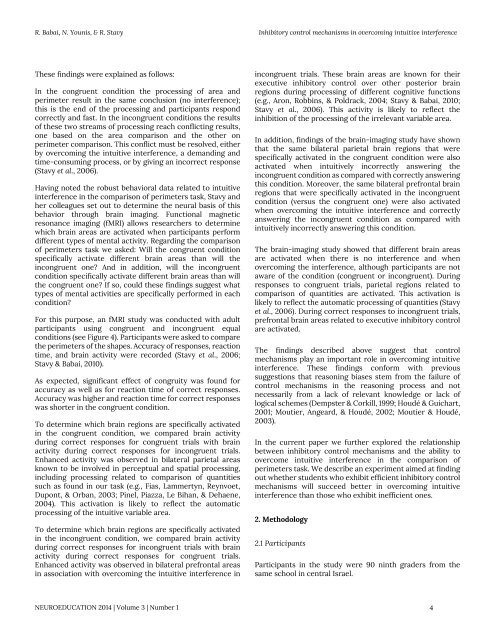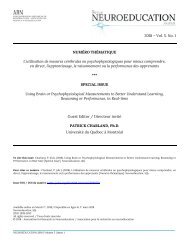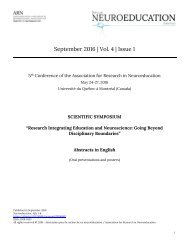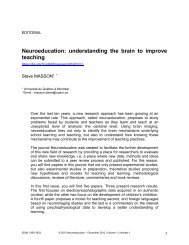Neuroeducation_2014_vol-3_no-1_full
Neuroeducation journal - Volume 3, Issue 1, 27 pages
Neuroeducation journal - Volume 3, Issue 1, 27 pages
Create successful ePaper yourself
Turn your PDF publications into a flip-book with our unique Google optimized e-Paper software.
R. Babai, N. Younis, & R. Stavy Inhibitory control mechanisms in overcoming intuitive interference<br />
These findings were explained as follows:<br />
In the congruent condition the processing of area and<br />
perimeter result in the same conclusion (<strong>no</strong> interference);<br />
this is the end of the processing and participants respond<br />
correctly and fast. In the incongruent conditions the results<br />
of these two streams of processing reach conflicting results,<br />
one based on the area comparison and the other on<br />
perimeter comparison. This conflict must be resolved, either<br />
by overcoming the intuitive interference, a demanding and<br />
time-consuming process, or by giving an incorrect response<br />
(Stavy et al., 2006).<br />
Having <strong>no</strong>ted the robust behavioral data related to intuitive<br />
interference in the comparison of perimeters task, Stavy and<br />
her colleagues set out to determine the neural basis of this<br />
behavior through brain imaging. Functional magnetic<br />
resonance imaging (fMRI) allows researchers to determine<br />
which brain areas are activated when participants perform<br />
different types of mental activity. Regarding the comparison<br />
of perimeters task we asked: Will the congruent condition<br />
specifically activate different brain areas than will the<br />
incongruent one? And in addition, will the incongruent<br />
condition specifically activate different brain areas than will<br />
the congruent one? If so, could these findings suggest what<br />
types of mental activities are specifically performed in each<br />
condition?<br />
For this purpose, an fMRI study was conducted with adult<br />
participants using congruent and incongruent equal<br />
conditions (see Figure 4). Participants were asked to compare<br />
the perimeters of the shapes. Accuracy of responses, reaction<br />
time, and brain activity were recorded (Stavy et al., 2006;<br />
Stavy & Babai, 2010).<br />
As expected, significant effect of congruity was found for<br />
accuracy as well as for reaction time of correct responses.<br />
Accuracy was higher and reaction time for correct responses<br />
was shorter in the congruent condition.<br />
To determine which brain regions are specifically activated<br />
in the congruent condition, we compared brain activity<br />
during correct responses for congruent trials with brain<br />
activity during correct responses for incongruent trials.<br />
Enhanced activity was observed in bilateral parietal areas<br />
k<strong>no</strong>wn to be in<strong>vol</strong>ved in perceptual and spatial processing,<br />
including processing related to comparison of quantities<br />
such as found in our task (e.g., Fias, Lammertyn, Reynvoet,<br />
Dupont, & Orban, 2003; Pinel, Piazza, Le Bihan, & Dehaene,<br />
2004). This activation is likely to reflect the automatic<br />
processing of the intuitive variable area.<br />
To determine which brain regions are specifically activated<br />
in the incongruent condition, we compared brain activity<br />
during correct responses for incongruent trials with brain<br />
activity during correct responses for congruent trials.<br />
Enhanced activity was observed in bilateral prefrontal areas<br />
in association with overcoming the intuitive interference in<br />
incongruent trials. These brain areas are k<strong>no</strong>wn for their<br />
executive inhibitory control over other posterior brain<br />
regions during processing of different cognitive functions<br />
(e.g., Aron, Robbins, & Poldrack, 2004; Stavy & Babai, 2010;<br />
Stavy et al., 2006). This activity is likely to reflect the<br />
inhibition of the processing of the irrelevant variable area.<br />
In addition, findings of the brain-imaging study have shown<br />
that the same bilateral parietal brain regions that were<br />
specifically activated in the congruent condition were also<br />
activated when intuitively incorrectly answering the<br />
incongruent condition as compared with correctly answering<br />
this condition. Moreover, the same bilateral prefrontal brain<br />
regions that were specifically activated in the incongruent<br />
condition (versus the congruent one) were also activated<br />
when overcoming the intuitive interference and correctly<br />
answering the incongruent condition as compared with<br />
intuitively incorrectly answering this condition.<br />
The brain-imaging study showed that different brain areas<br />
are activated when there is <strong>no</strong> interference and when<br />
overcoming the interference, although participants are <strong>no</strong>t<br />
aware of the condition (congruent or incongruent). During<br />
responses to congruent trials, parietal regions related to<br />
comparison of quantities are activated. This activation is<br />
likely to reflect the automatic processing of quantities (Stavy<br />
et al., 2006). During correct responses to incongruent trials,<br />
prefrontal brain areas related to executive inhibitory control<br />
are activated.<br />
The findings described above suggest that control<br />
mechanisms play an important role in overcoming intuitive<br />
interference. These findings conform with previous<br />
suggestions that reasoning biases stem from the failure of<br />
control mechanisms in the reasoning process and <strong>no</strong>t<br />
necessarily from a lack of relevant k<strong>no</strong>wledge or lack of<br />
logical schemes (Dempster & Corkill, 1999; Houdé & Guichart,<br />
2001; Moutier, Angeard, & Houdé, 2002; Moutier & Houdé,<br />
2003).<br />
In the current paper we further explored the relationship<br />
between inhibitory control mechanisms and the ability to<br />
overcome intuitive interference in the comparison of<br />
perimeters task. We describe an experiment aimed at finding<br />
out whether students who exhibit efficient inhibitory control<br />
mechanisms will succeed better in overcoming intuitive<br />
interference than those who exhibit inefficient ones.<br />
2. Methodology<br />
2.1 Participants<br />
Participants in the study were 90 ninth graders from the<br />
same school in central Israel.<br />
NEUROEDUCATION <strong>2014</strong> | Volume 3 | Number 1 4








